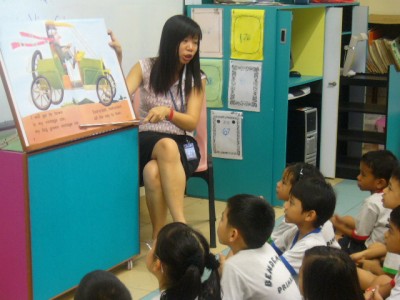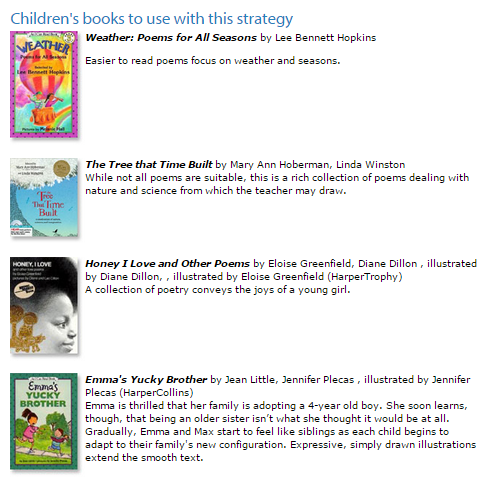SHARED BOOK EXPERIENCE
Definition/Description:
The shared book experience strategy is used to develop early literacy concepts, specifically oral language. It is an interactive reading experience that takes place when share the reading of a book/text while the teacher guides and supports their learning and literacy development. This strategy is often used to imitate the "bedtime story" in which many students experienced as children, and therefore they can relate to the story and activate their prior knowledge and background as well (Jennings, Caldwell, and Lerner,2014). In this strategy the teacher typically want to use predictable books or books with patterns, especially in younger grade when first learning about oral language concepts. “The teacher explicitly models the skills of proficient readers, including reading with fluency and expression. The shared reading model often uses oversized books (referred to as big books) with enlarged print and illustrations” (Reading Rockets, 2015). This strategy really consists of four reading areas, comprehension, fluency, choral reading, and on print knowledge/concept.
The shared book experience strategy is used to develop early literacy concepts, specifically oral language. It is an interactive reading experience that takes place when share the reading of a book/text while the teacher guides and supports their learning and literacy development. This strategy is often used to imitate the "bedtime story" in which many students experienced as children, and therefore they can relate to the story and activate their prior knowledge and background as well (Jennings, Caldwell, and Lerner,2014). In this strategy the teacher typically want to use predictable books or books with patterns, especially in younger grade when first learning about oral language concepts. “The teacher explicitly models the skills of proficient readers, including reading with fluency and expression. The shared reading model often uses oversized books (referred to as big books) with enlarged print and illustrations” (Reading Rockets, 2015). This strategy really consists of four reading areas, comprehension, fluency, choral reading, and on print knowledge/concept.
|
Justification: "Oral language development forms the basis for reading and writing. Thus, it is critical that parents and teachers of young children foster oral vocabulary development. Vocabulary and concepts development lay the foundation for background knowledge needed in reading comprehension" (Jennings, Caldwell, and Lerner,2014). The use of the shared book strategy allows readers to build sight words, word knowledge, and fluency (Holdaway, 2009). Also, because of the modeling part with the teacher it allows students to enjoy material that they might not have been able to fluently read and comprehend on their own. Lastly, “It provides struggling readers with necessary support” (Reading Rockets, 2015). This strategy overall allows students to work on print concept knowledge as well as fluency as the teacher models what a fluent read does and sound like. Building vocabulary, both academic and content, is essential for students’ academic success. “When new vocabulary knowledge develops, students will be able to create a deeper understanding of the text and the content it represents” (Miller and Veatch, 2011).
This video above, gives examples of books teachers can use, how teachers should read and do a share book lesson. Then it gives an examples of a lesson that the teacher taught using the shared book strategy.
Some examples of book sot use given by our text include:
|
What is a share book experience? How can teachers effective teach a share book lesson and engage there students? What the video above on tips and teacher skills that will help teach an effective and engaging share book experience lesson!
Differentiation:
Steps:
1. Choose a book related to your students and a specific concept or standard you were wanting to teach.
Specific to Individual Students:
|
|
The teacher in this picture is demonstrating how to effectively hold the book so that all students can view the pictures on the page and the words. This is essential when teaching students about print concepts and knowledge because then they can visual see the words and pictures.
Content Are Examples:
Language Arts: Choose a big book to read to class. Start lesson by activating prior knowledge and build background knowledge. Introduce the book to students and have them predict what it will be about as they look through the pages. Read the book aloud making sure to point to each word and demonstrate fluency. Reread book again and have students join in. Follow up with a activity relate to book that depends students understand of the content or topic. Math: Teacher can read a story about a math concept using the shared book strategy and follow lesson up with the activity for examples. A teacher can read a book about adding numbers, go through the reading steps of this strategy and at the end he/she can have students do a math activity that is related to the content. Science: Teacher can read a story about a specif science content, such as world Photosynthesis or the life cycle. Teachers read the book and then go through the steps. The teacher can finish the lesson with a projects, graphic organizer, or activity sheet that goes along with the science concept and deepens the students understanding. Social Studies: Teacher can read a story about a specif social students content, such as world war 2 or The state of MN and go through the steps of this strategy. Teachers read the book and then go through the steps. The teacher can finish the lesson with a graphic organizer to compare the book or to build on background knowledge or skill. |
(Reading Rockets, 2015).
|
References:
Holdaway, D., (2009). Shared book experience: Teaching reading using favorite books. Theory Into Practice Journal.
Jennings, J., Caldwell, J., & Lerner, J. (2014). Reading problems assessment and teaching strategies. Boston, MA: Pearson Education, Inc.
Key Links Shared Reading (2010). Scholastic. [Web video]. Retrieved from https://www.youtube.com/watch?v=jfGjgOc-rJw
Miller, M., & Veatch, N. (2011). Literacy in Context (LinC): Choosing Instructional Strategies to Teach Reading in Content Areas for Students Grades 5-12. Pearson.
Mrs Joyce Lim using the Shared Book Approach. (n.d). [image] Retrieved from http://www.bendemeerpri.moe.edu.sg/cos/o.x?c=/wbn/pagetree&func=view&rid=33847
Shared Reading. (2015). [image] Reading Rockets. Retrieved from http://www.readingrockets.org/strategies/shared_reading
Shared Reading. (2015). Reading Rockets. Retrieved from http://www.readingrockets.org/strategies/shared_reading
Shared Reading. (2010). [Web Video] Retrieved from https://www.youtube.com/watch?v=E2zVJp_HeeM
Holdaway, D., (2009). Shared book experience: Teaching reading using favorite books. Theory Into Practice Journal.
Jennings, J., Caldwell, J., & Lerner, J. (2014). Reading problems assessment and teaching strategies. Boston, MA: Pearson Education, Inc.
Key Links Shared Reading (2010). Scholastic. [Web video]. Retrieved from https://www.youtube.com/watch?v=jfGjgOc-rJw
Miller, M., & Veatch, N. (2011). Literacy in Context (LinC): Choosing Instructional Strategies to Teach Reading in Content Areas for Students Grades 5-12. Pearson.
Mrs Joyce Lim using the Shared Book Approach. (n.d). [image] Retrieved from http://www.bendemeerpri.moe.edu.sg/cos/o.x?c=/wbn/pagetree&func=view&rid=33847
Shared Reading. (2015). [image] Reading Rockets. Retrieved from http://www.readingrockets.org/strategies/shared_reading
Shared Reading. (2015). Reading Rockets. Retrieved from http://www.readingrockets.org/strategies/shared_reading
Shared Reading. (2010). [Web Video] Retrieved from https://www.youtube.com/watch?v=E2zVJp_HeeM


